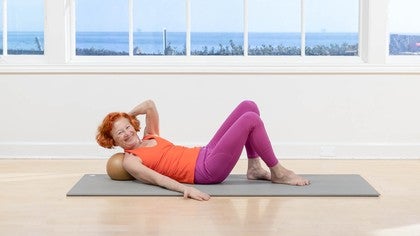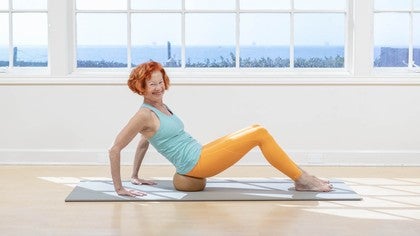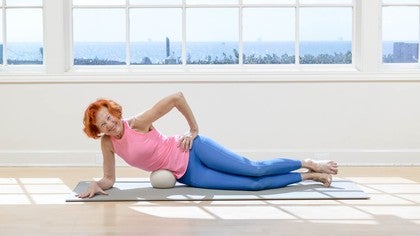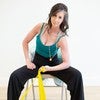Description
Props Needed: Gold Yamuna USA® Ball or something equilvent
About This Video
Transcript
Read Full Transcript
Welcome to the routine for the trapezius. This is king in my mind. This is a muscle that we all complain about when we have neck problems and our shoulders are hiked up and it's pending that you've released your pecks. You can't really resolve the back body until you've cleared that up, but we've done that already. This muscle is very big.
It starts at the base of the ribs and moves out to the top of the shoulder blade right here and then from the neck down. So it's kind of a diamond-shaped structure. And think about it, any place that it can be stuck with congestions, adhesions, fascia's pulling in, and the texture of the muscle isn't working. You can be really tight at the bottom of the trapezius and it affects the top. So it's always essential to roll out the full muscle pattern not just get into one area because it's tight.
We will be starting the routine at the base of the rib cage. If you put your hands on your hips, on your waist area and move back and you just bend over a little bit and feel your ribs go really, really low down there, they just about come to the waist and that's where the trapezius attached and start. They attack all the way up the spinal column and out. So we're going to start at the bottom and roll out. Come a little higher up, roll out across the base of the shoulder blade, roll up even higher and roll out, (laughs).
And we're rolling out and up towards the top of the shoulder and then we're coming to the right at the top of the ribcage and rolling across to the top of the shoulder. Then we will roll up the neck, lengthening that part out, and roll down and out and grab the part that we're all aware of and press it down. This muscle very often is key when... Sometimes women can have this bone really bulging and kind of a humpy-shape in here where there's fat that builds up, it's usually connected to the trapezius. You get into that and you start to break up that pattern, which they love and I love as well.
So you're going to take the ball, place it at the base of the ribs and kind of be in touch with your waist as well on the right side. So where we are, we're starting out, we're taking a breath in and we're pressing into the origins of the muscle way down there. We're feeling the side of the spine and the rib cage. Every time you start in a routine you want to connect to the origins of the muscle and the bony structure around it in order to stimulate that area, soften that area. It's like you start a whole chain reaction throughout the whole muscles pattern to start to release and elongate.
The fascia just kind of goes, pffrtt. It's like you're opening up a circuit. Roll a little bit higher up and roll on a diagonal out slightly. Again, take a breath in, and a breath out. So now you're into the low ribs, sink into it.
You probably can start to feel if you've been doing some rolling movements for a while that the bones and the tissues start to be softer and more flexible and healthier really. Take another breath in, breathe out, and roll a little bit further out on a diagonal, outwards. Take a moment here, widening the ribs, opening the area up and then come back and come a little bit higher on the spine. So now you're into the rib cage area. You're aiming towards the shoulder blade.
So take a breath, and breathing out, press in. Because we're working with a larger ball surface, it stimulates on a more global level. If you are a beginner or you have injuries, a bigger softer ball is better than a smaller, more focused ball. And again, body size is a factor in all of this. So there's not one ball fits the exercise, it's really dependent on a lot of factors.
So start to roll on a diagonal out from the spine. You want to keep in touch. Here's your shoulder, you want that kind of line up in that direction and you'll start to feel the low tip of your shoulder blade. Take a breath in, take a breath out, sinking in. Imagine pushing the shoulder blade up a little bit and the rib up a little bit.
One more time, breathing in, breathing out, because we want that tissue gliding, and you move up a little bit further, maybe towards the armpit. So we're widening, pressing out, stretching that tissue. One more time, breathing in, breathing out, and roll a little bit further up towards the shoulder area. Take a moment here. It will attach.
Remember this muscle attaches right at the top of the shoulder blade and the top here. This is the area we all know about. Then you come back towards the spine. Now we are base of the shoulder blade proper. We're feeling into that area.
It's a big ball, so it's going above and below. Take a breath in, breath out, and think of aiming in the direction of your shoulder. You want to soften the area up and you want to start to think of widening the tissue away from the spine. Roll a little bit further up. You're now going right into the shoulder blade.
Take a breath, breathing out, and start to press into the tissue right at the top. This, a lot of congestion in here, 'cause most of us have our shoulders hiked up. You can also let the neck start to drape a little bit. If you feel knots and cords and tight tissue, that's fantastic, because that's what we're looking for. We're looking for the deep programs that are really bringing us to our knees or keeping us fixed in one pattern of behavior, one personality, one automatic response to life, because we've just been kind of glued up into a place that's not our native place.
We're just ungluing all of this. Take a little bit more time to roll into this area. Notice that I've now literally starting to rotate my body and my neck in. So I'm also getting pressure into my neck. Take a moment.
And then come back. Now you're right at the top. This is that where C7 is, the top of the shoulder blades. The very top of the rib cage. You want to feel into this area.
So there's neck as well the right side, take a breath in, press into this area. You can also start to press your head in. Big breath in, big breath out, pressing in and out, start to iron out the top of the shoulder blade, that wing area. Feel it moving away from the spine. Big breath in, breathing out, rolling a little bit more to the left and starting to press into the top of the shoulder.
It's kind of a tricky angle to get into. That's why this bigger ball is so much more effective for most people. Take another breath in, breath out, and start to roll a little bit further out. So you're widening the wing of the shoulder and we're starting to get on top of the shoulder blade just a little bit. It's tricky area to get into, but we're doing it.
Take a moment here. And then come off. And now we'll go up into the neck. So take the ball and place it right at the base of the neck on the right side. So a big ball, your whole neck is gonna fit in there.
You want to feel the pressure into C7, all the way up to the occipital bone. Take a breath in, breath out, push into the ball and start to drag your body down a bit and feel how the ball is starting to catch the top of the skull and lift it up. So you're lengthening the back of the neck. You want to take the shoulders and pull them down. So we're getting that trapezius muscle to start to be traction in opposite direction.
On an in breath, lift your hips a little bit, and pull the shoulders even further down, keeping that ball, pushing into the skull. Come on down, and roll the ball a little bit out. So we've moved the ball to the right of the skull. It's catching the corner of the skull you could say, and now start going down again. So we're on an angle, rolling down the neck and slowly rotating.
As you do this, if you catch tight spots, take your time. Do this more than once and stop where you feel tight because that's the gold, and you sometimes can take two minutes, five minutes, to really shift the tissue there. It's worth the time, because once you open it once your whole whole physiology changes and it's much easier to release. Again, take another breath, roll a little bit further. So I'm rolling onto my side, ironing out this muscle, and dragging this shoulder and arm down to open up the trapezius and put pressure into it.
Take a breath, lengthen your chin a bit, breathing out, roll to the side. Now you want to keep adjusting until you can get the ball wedging the shoulder down. You're pressing that shoulder away from the ear and you're putting traction into it. You may find that there's a lot of tightness here because that's where you're at right now. Big breath, breathing out.
Start to roll a little bit forward and backwards. So you're releasing the tissue on the side of the neck and pressing the shoulder down. From here you can also take the head, press it and push the shoulder down. Take a moment to feel that traction and you can move the arm up and down to discover more areas of adhesions because the ball is keeping your shoulder from going up, and you may find you have a certain amount of restriction in the arm movement without the shoulder. We want to get that trapezius nice and long on that side.
Also move the hand behind your body. I am now taking the palm of the hand and I'm rotating it into the floor, so it's externally rotated and again slightly rolling back and forward on the top of the shoulder to get the tissue of the trapezius really unstuck. I'm rolling towards the collarbone, pushing the collarbone down. And then rolling back towards the wing of the shoulder blade to get that unstuck. So that top area of the shoulder, so hard to get into, and with a big ball you're doing it can be quite intense and powerful the first time and massively transformative.
So just spend a little time here, we'll take one last breath in, (inhales), breath out, push that trapezius muscle way down, wait for it to release, wait for the throat to release, wait for the neck to release. And then come off the ball, lie on your back, and check out what you feel like. Take a moment. And very often people are bright red when they do this because so much circulation has been opened up. And again the shoulders are wider, the back is flatter.
Just notice what you feel. Notice your own physiology. Enjoy the sensation. And let's come up and start the other side. So coming up, getting the gold ball at the area of the waist where you can start to feel the ribs on the left side this time.
Let me get myself at the top of the mat, 'cause I'll walk down. So take a moment. Breath in, breath out. Press into that area of bone going into the tissue to the side. Your intention is to create a diagonal.
Remember we're working on that kind of diamond shape of muscle. Again, breathing in, breathing out. If there's any tightness here it can be affecting your neck and your shoulders. It's amazing, but it's true. And then roll a little bit higher up and a little bit more to the side.
Take a breath, breathing out, press into the ball and roll a little bit further out. So we're starting this diagonal journey to widen up the ribs, widen everything up. So our trapezius and our lats overlap, many muscles that have layer one on top of the other. And so you will often find that you're rolling along the same line but we're tracking a different muscle group as we do it. Now come back and get right onto the ribs proper.
It's a bigger ball, so you will probably feel the left side of the ribs, the spine, and possibly the bottom of your shoulder blade. Big breath in, inflate this area, breathing out, press into the ball and start to roll on a diagonal up and out. You're aiming in the direction of your armpit. Big breath. Breathing out.
So you're traveling through the shoulder blade, lengthening it, widening it, and moving towards the armpit area. Take a moment. Feel the opening. I will often rotate the opposite rib cage to get more traction into the position. And then come back, move the ball higher up.
Now it's at the base of the shoulder blades, middle of the shoulder blades. It's a less, more shallow angle towards the top of your arm. So we're aiming out towards the corner of the top of the shoulders. Big breath, soften into this area. I often will take my head back more.
Notice I'm not arching and draping, I'm pressing and lengthening. We want that spinal column long. The ribs tend to be very rounded in the back for some people, we want to start to open them up and lengthen them, create more space. Breath in and breath out, roll across the shoulder blade. This area can start to have some more sensitive tissue talking to you.
That's all good. If it's sensitive, it needs love. It needs pressure. We are pressure loving creatures. It pushes the lymph.
It pushes the fascia. It starts to even out the texture. So keep rolling until you get towards the top of the shoulder, going into the whole upper part of the shoulder blade. Take a moment here and then come back and let's go right at the top of the, kind of the T-section. We want the ribcage, we want C7, emphasis is on the left side.
The shoulder blades on either side. The left side is our focus point. This area right here has lots of congestion. Take a moment and breathe in and see how much pressure. I'm using my feet and I'm using my whole trunk to press in and spread the area out.
You want that tissue widening, opening up. You want to visualize everything spreading. Take a breath in and start to move your body to the right. So the ball is moving across the top of the shoulder blade and starting to aim towards the very top, that area that if you were standing up would face the ceiling. Big breath in, go further out and start to really rotate.
So it's getting kind of back and top of the shoulder. You want to aim into it. You also getting the neck. So take some time here, feel into the sensation of what's happening. See if you can widen the shoulder blades more.
Widen the trapezius, and go a little bit further out, so you get into the outer corner of the shoulder blade into the edge with the arm and the top. So we're ironing out this area and eventually you will roll onto your side. Just a little bit, starting to get into the, where the area, where the trapezius is attaching, both to the collarbones and to the shoulder blades. Take a moment, and then come back to that corner area of the spine. The focus is on the left side.
So you've got C7, that bulging area, the shoulder, the widening aspect of the shoulders and the neck. Take a breath and roll the ball up to traction the neck, pull your shoulders down. Start to feel the pressure of the ball, lifting the skull off the neck. Take a moment here. Breathing in, breathing out.
If you can get the shoulders even lower and get the ball to grab the skull, that's wonderful. Lift your hips and pull the shoulders even more down. So you can get a huge elongation starting to kick in. Relax the chin, lower yourself down. And now on a diagonal you start coming back down and rotating.
So we're rotating through the neck, keeping it long, rolling the ball down. Lots of fibrous, tight tissue in this area. Neck gets very congested and there's a lot of muscles, we're working specifically into the trapezius which goes from the skull and spreads out onto the shoulders, at top of the shoulders. So you want to get into this area and slowly get the ball wedged. So it's pushing the shoulder down, lengthening the whole side of the neck, creating a huge length in the neck and space between the shoulder and the neck.
Slightly rotate your chin forward and backwards to open up more tissue. The ball is keeping this area open so you can really get a lot of freedom coming into the skull once you start to open it up. Use your hand to press your skull over the ball, stretch it even further. Keep dragging the shoulder down. And then move the front arm up and down a little bit to find if you have any additional adhesions or tightnesses in the tissue that you want to release.
Keep pressing the shoulder down and move the arm behind you. And you can move it out. You can have it internally or externally rotated. I like to work into this shape. And again, rolling a little bit forward and backwards on the ball while keeping the shoulder down to just have all of these attachments starting to release and open.
Take a moment. Take one last deep breath in. Breathing out, relax and release as much as you're able to. This is a pretty intense routine for many people. See if you can soften a little bit more.
And then come off the ball, lie on your back, enjoy the release. This is the fun part. What do you feel like after it's over? What do you notice? What's different in your body?
Just take a moment to check in. How does your right and left side relate to each other? How does your spine feel? And when you're ready, bring yourselves up to a seated position and check in one more time. Usually the shoulders can be a few inches lower than they were and maybe the neck is much more upright and floating upwards with a lot of freedom.
Just for fun, lift your shoulders and it doesn't feel good. Let them drop back down, they feel much better down there. So I hope you enjoy how you're feeling, enjoy the space and the openness. If you had a lot of congestion, visit this routine more than once. The more you do the work, the quicker and faster and more permanent the changes are.
Thank you very much.
Release Your Fascia: Upper Body Freedom
Comments
You need to be a subscriber to post a comment.
Please Log In or Create an Account to start your free trial.



















